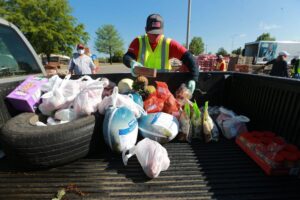By: Danny McArthur

Tupelo • Mobile food banks have been occurring throughout North Mississippi and the MidSouth to address ongoing food insecurity as a result of COVID-19.
Mid-South Food Bank, located in Memphis, has deployed mobile food pantries all throughout its 31-county coverage area in west Tennessee, North Mississippi and east Arkansas, said communications manager Andrew Bell.
“Since the pandemic, the Mid-South Food Bank went into emergency mode, which means we accelerated getting the food out as quickly as possible. We’ve been channeling dozens of mobile pantries every day, every week,” Bell said.
Mobile food pantries was a program Mid-South already offered prior to the pandemic.
As pandemic-related unemployment rose and caused more people to need food, Mid-South accelerated the usage of mobile food pantries to ensure more food went to communities in need. They have primarily focused on rural areas that have already been suffering, such as Tunica County in the Delta, and are trying to reach other rural areas such as Tate County, where people may not have transportation to reach food sources.
“Getting more food out in the rural areas in Mississippi has obviously been a priority because there’s one thing not to have access to food, and then there’s another when you have no access for anything,” Bell said.
Tupelo/Lee Hunger Coalition Executive Director Jason Martin, who has worked with Mid-South Food Bank as part of Toyota Mississippi’s mobile food pantries, said they utilize mobile food pantries to help fill in the gaps in areas where there are not enough brick and mortar food pantries or existing food pantries cannot meet the growing need.
Mobile food pantries and other food service programs have seen an uptick in the number of clients using the service, with an influx occurring in April as a result of unemployment. A common trend both Bell and Martin noticed was the number of people who have become newly food insecure as a result of losing employment.
“I spoke with multiple individuals that, prior to (losing employment) had full time jobs and had been working at their place of employment 10, all the way up to 35 years,” Martin said. “They had steady employment without any concerns of food insecurity, and then COVID put their family and situation into turmoil. All of a sudden, they found themselves with a need to find additional food sources.”
In addition to being food insecure, Martin said many families and individuals were not previously aware of what resources were available and needed help navigating them. Even with the growing need, there is a base of regular clients who typically make sure of food pantry services, whether that is those with long-term disabilities, grandparents caring for grandchildren, single mothers, part-time workers, etc. Since the pandemic started, Bell said the dynamic of clients has changed to include people of all ranges of demographics and income levels.
“It’s not just the amount of people. It’s the people that didn’t know anything about getting food assistance have now found themselves getting food assistance, and it’s opened their eyes to what a lot of people go through on a regular basis,” Bell said.
Bell said it’s “shined a light on food insecurity.” Mid-South often finds clients who didn’t know the layers of food insecurity. He called food insecurity the “number one sign post for poverty.” Many have to choose between food and other necessities. Bell said that food stamps “only go so far,” and that people who are food insecure for long periods of time often have terrible diets that can eventually cause health issues.
New stakeholders, many of which are non-profit organizations and churches, have stepped up to locate the need in their area. Host agencies supply volunteers, location and setup. Bell said these partnerships have been hugely critical, as Mid-South does not have the manpower to handle distribution without agencies.
“It’s been a very helpful, cooperative collaboration among ordinary people who may or may not have been food insecure but wanted to take a risk and (fill an) important need,” Bell said. “If we didn’t have the volunteers or the churches supplying the volunteers, I don’t know how we would get the food out.”
Eleven counties within the Daily Journal’s coverage area hosted 42 mobile pantries with Mid-South, distributing a total at 1,297,819 pounds through both agencies and mobile pantries with 12 counties from March 29 to June 15. Itawamba County did not host a mobile pantry, but distributed 20,345 pounds through agencies.
Martin said the Tupelo/Lee Hunger Coalition assisted Toyota Mississippi when it hosted mobile food pantries in its impact area of Lee County, Prentiss County, Pontotoc County and Union County. They served a total of 2,250 households.
“The role of the mobile food pantries is not only to take food into areas that were affected and impacted by COVID, but also it took some of the pressure off the existing brick-and-mortar food pantries,” Martin said. “As a result, those pantries that were able to continue providing services were not impacted as heavily as they could have been had those mobile food pantries not been in existence or in place.”
Martin additionally pointed out that for Prentiss County, where there isn’t a regular brick-and-mortar food pantry, the community was lifted up because of the mobile food pantry.
As the partner agency, Toyota Mississippi chose locations for all four mobile food pantries. The Lee County mobile pantry occurred at the BancorpSouth Arena due to the ample parking lot space, but Martin said they realized there was no protection from weather. For future locations, they turned to Mississippi Emergency Management Agencies in each county to find locations and determined agricenters would be best due to having both adequate parking and cover that would allow them to stage food even in inclement weather.
Other mobile food pantries occurred in surrounding cities such as Aberdeen, Nettleton, Baldwyn and others. While some requirements to qualify have been relaxed, many agencies still use USDA established requirements to determine service. Martin predicts mobile food pantries being an ongoing need due to brick and mortar food pantries struggling to find additional volunteers and the logistics being easier for mobile food pantries than brick and mortar pantries.
Martin notes that food pantries still play a critical role in COVID food response. Whereas mobile pantries rely heavily on donated products, meaning there may be a lot more fresh items and less quantities of shelf-safe items, brick-and-mortar tend to have a blend of perishable and nonperishable items, including a blend of fresh items, frozen food and dry goods. He also notes that mobile food pantries tend to occur at a particular time of the month, meaning if there is an emergency food need, mobile food pantries cannot fill it.
“I think that is where some of the other agencies are picking up and filling in those gaps,” Martin said.
Bell said that food banks across the country are receiving many donations, but those donations are immediately going towards those in need. With the pandemic remaining an ongoing concern, organizations aren’t sure when the need will end. He said while they have received plenty of donations so far, it could be an issue if the need lingers but donations drop in the fall.
For Mid-South Food Bank, the most effective way to help is financial donations. Because they have charitable status, Mid-South is able to provide 30 meals, or 30 pounds of food, for $10, meaning “a little … goes a long way”, Bell said.
“That’s why food banks exist,” Bell said. “We’re equipped to offer a lot more food for a lot more people versus just a pantry that’s doing the same thing independently because of the volume of food that we get in.”
He also encourages people to organize within their own community and assist those in the community who lack food access.





